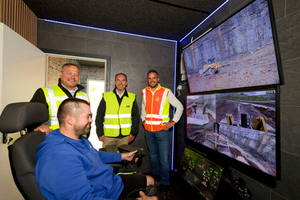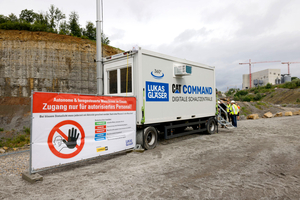Lukas Gläser relies on Cat Command remote control for raw material extraction
for the first time in Germany
Over the next few years, raw material will also be extracted along a final extraction wall, i.e. along the authorised extraction limit. In order to reclaim the deposit as completely and sustainably as possible, a final extraction wall at an almost vertical, continuous height of the deposit thickness of around 70 m should be aimed for. This has so far been ruled out in accordance with DGUV regulation 29, paragraph 13. For a few weeks now, Lukas Gläser has been permitted to do this by means of an exemption licence, according to BG Bau, because thanks to Cat Command, any risk to the excavator driver can be ruled out. The driver moves the construction machinery from a safe distance – there is no danger to him. A risk assessment was required for the use of the construction machinery technology when the excavator is working underneath and along the wall. “Thanks to the remote control, we can significantly improve safety for the employee and keep him completely away from the danger zone. A nice side effect: most accidents or falls occur when climbing up and down because drivers jump off their equipment and twist their ankles, for example. This risk also no longer exists,” says Dr Peter Antweiler, authorised signatory and technical manager of the Lukas-Gläser Group’s raw materials operations.
At steinexpo 2023, he saw a Cat 323 crawler excavator in operation for the first time, which was remotely controlled from an external control station in a trailer opposite without an operator sitting in the cab. “The fact that we were able to commission the machine at our quarry in such a short space of time in July was very ambitious. But we have the courageous decision of the prevention department of BG Bau in Berlin to thank for this, which approved our application after just two months. So it is a good example of the use of effective technology that contributes to safety and in turn allows us to fully utilise the resources of the deposit and make full use of the area in the quarry,” explains the authorised signatory. The fact that BG Bau gave the green light for the use of Cat Command to carry out the dismantling below the wall was also due to the fact that there is a manual transmitter with which the remote connection to the machine, whether excavator or dozer, can be disconnected and can also only be re-established via this transmitter. This means that the employee repairing the machine, for example, can be sure that the machine will not start moving remotely without his authorisation. But this is not the only safety precaution that has been taken. To prevent people from unknowingly approaching the unmanned construction machines when they are working remotely, warning signs have been installed on the site. During dismantling, it is not permitted for third-party vehicles to be present where the Cat 395 is working. The crawler tractor is not used in remote operation when third-party vehicles are travelling in the filling area. It operates with a time delay in the immediate danger zone below the high final excavation wall to prevent too close contact with delivery traffic.
Lukas Gläser made a conscious decision in favour of a control system that relies on radio for continuous data exchange. “We deliberately wanted to keep our employees in the quarry so that they remain familiar with the quarrying conditions,” explains the technical manager of the raw materials operations. The group of companies selected three experienced employees, who are already familiar with operating a crawler tractor and a tracked excavator, and who range in age from their early 20s to their early 50s, for the Cat Command control system. The main requirement placed on the three machine operators: They had to show an interest in remote technology and embrace a new form of machine control. “Drivers absolutely need to have a feel for construction machinery, as they can no longer directly sense if their machine is leaning too far to one side. This simply requires experience to know how far you can go as a machine operator if you only move the machine using monitors,” says Dr Peter Antweiler. To learn how to use Cat Command and make the technology their own, the three employees were instructed and trained in its use by specialists such as Christian Berling, Caterpillar sales representative for Cat Command, in Málaga, where Caterpillar has maintained its Demonstration and Learning Center since 1971.
Taking employees on board and involving them are basic requirements in change management so that the team accepts and embraces new systems like this one. “Unfortunately, our industry has an image problem. With remote control, we can also inspire young people to work in a quarry,” hopes Christoph Kübler, Managing Director of Lukas Gläser, and that was his motivation for investing in the technology. After all, Cat Command is already the precursor to the self-propelled construction machine and the autonomous quarry. “By getting involved in remote control, we are sending out a signal that we are ready for this and want to be part of the development from the very beginning,” emphasises Dr Peter Antweiler.
The operating station, housed in a modern container outside the danger zone, has become the new workplace for the employees. They had a say in the design, which was utilised. “For example the windows were darkened – at the special request of the machine operators. They don’t want to have eye contact with their work equipment so that they don’t get the wrong impression due to the spatial perspective. It is also important for them not to be distracted by outside interference, but to concentrate fully on the screen displays and orientate themselves exclusively on them,” explains the technical manager of the raw materials operations. Four cameras mounted on the machine are standard with the command kit. They are needed to provide the driver with a real-time video stream of the construction machine’s movements on the screen in front of him.
It was also noticeable that the younger generation of employees were able to familiarise themselves with the new system much more quickly and easily. “The drivers still have to be able to categorise the movement of the excavator and dozer on the monitors as a 2D display. This requires a feeling and basic understanding that can only be developed if you understand how the construction machinery works and if you work regularly with Cat Command. Specifically, an operator has to orientate himself by completely different reference points when he empties the bucket of the Cat 395 in the skip,” explains Dr Peter Antweiler.
The current focus is on consolidating the processes in Lukas Gläser’s raw materials operation, but the receiver and transmitter of the radio frequency also need to be improved. There is still a fault. There are currently construction cranes on the site that are building the Lukas Gläser Group’s new ballast plant. They use a radio frequency in the same way as crushers and drilling equipment in the extraction of raw materials. “However, we can rule out the possibility that this is causing interference and must get to the bottom of the cause. A fundamentally new control system like this first has to familiarise itself and it was clear that there would be teething problems. At Cat, however, we know that a system like this has been extensively tested and will only be introduced if it works,” says Dr Peter Antweiler with conviction.











